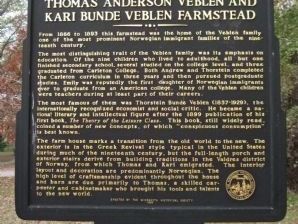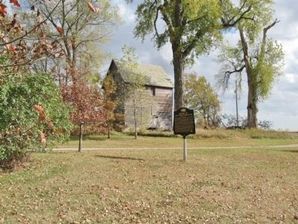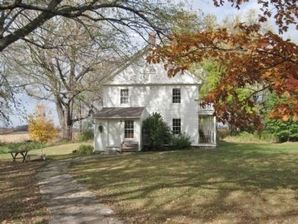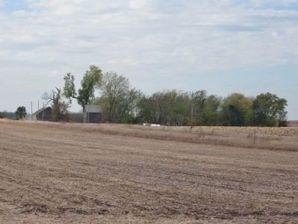Thomas Anderson Veblen and Kari Bunde Veblen Farmstead / History of the Veblen Farmstead
Thomas Anderson Veblen and
Kari Bunde Veblen Farmstead
From 1866 to 1893 this farmstead was the home of the Veblen family one of the most prominent Norwegian immigrant families of the nineteenth century.
The most distinguishing trait of the Veblen family was its emphasis on education. Of the nine children who lived to adulthood, all but one finished secondary school, several studied on the college level, and three graduated from Carleton College. Both Andrew and Thorstein completed the Carleton curriculum in three years and then pursued postgraduate studies. Emily was reputedly the first daughter of Norwegian immigrants ever to graduate from an American college. Many of the Veblen children were teachers during at least part of their careers.
The most famous of them was Thorstein Bunde Veblen (1857-1929), the internationally recognized economist and social critic. He became a national literary and intellectual figure after the 1899 publication of his first book, The Theory of the Leisure Class. This book, still widely read, coined a number of new concepts, of which "conspicuous consumption" is best known.
The farm house marks a transition from the old world to the new. The exterior is in the Greek Revival style typical in the United States during much of the nineteenth century, but the full-length porch and exterior stairs derive from building traditions in the Valdres district of Norway, from which Thomas and Kari emigrated. The interior layout and decoration are predominantly Norwegian. The high level of craftsmanship evident throughout the house and barn are due primarily to Thomas, a skilled carpenter and cabinetmaker who brought his tools and talents to the new world.
History of the Veblen Farmstead
The Veblens lived in Wisconsin from their arrival in 1847 until 1865, when they moved to Minnesota. They were attracted to this area by the good farmland and the presence of several relatives nearby.
In 1864 Thomas Veblen bought 200 acres of unimproved land surrounding this site. In 1865 he purchased another 90 acres of partly cultivated land just east of what is now Norstrand Woods State Park. The family lived in a house on the smaller farm following their arrival in July 1865.
Work soon began on the new house. Foundation stones were quarried in what is now Norstrand Woods State Park and hauled to this site during the winter. By the fall of 1866 the foundation walls had been completed and covered with a temporary roof. The family moved in late that year. The shell of the house was probably erected in 1867 and the house assumed its final form about 1870. The barn was erected around 1872.
The site operated as a farm until 1970. The homestead was placed on the National Register of Historic Places in 1975 and designated a National Historic Landmark in 1981. The survival of the farm buildings is due principally to the efforts of the Veblen Preservation Project, which raised funds to purchase the abandoned buildings and surrounding ten acres in 1982 and which made critical repairs. In 1992 a private individual purchased the property and assumed responsibility for its restoration. Thanks to the dedication and cooperative efforts of many individuals and groups, the house of Minnesota's "disturbing genius" and this remarkable family has been preserved and meticulously restored as a reminder of Norwegian-American immigrant life in the last half of the nineteenth century.
seal of the Minnesota Historical Society
Erected by the Minnesota Historical Society
1996








